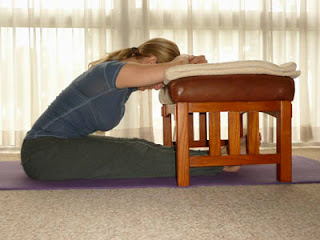Sanskrit:
Gomukhanasana Western Term: Cow-Face Pose
Origin of Word Go = cow; Mukha = face
Saying “moooooooooo” may
help release tension from mind and body, it also may help with breath
Type of Asana: seated pose
How To:
1.
Sit on the ground with your head and spine
erect. Extend both legs straight out in front of you in dandasana (staff
pose). Place your palms down on either side of your hips bringing the weight
into your hands. Raise your body above ground level so that you can bend your
right leg backward and sit on your right foot. Using the help of your hands (if
necessary), bend your left leg so that your left knee is over your right knee
and the left heel touches the right heel (or lower part of your right thigh in
early stages).
2.
Inhale as you reach your right arm out to the
side. Exhale bending the right arm at the back, bend the arm at the elbow and
lift the forearm upward. Lift your left arm over the shoulder, bend it at the
elbow and place the left hand at the back below the neck. Try to connect the
fingers of both hands behind the shoulder blades with your head upright.
3.
Stay in the posture for about a minute or until
your breaking point (you’ll know your breaking point, each person has a
different point).
4.
Make sure to do both the right and left leg and
arm.
Body Points:
*keep knees on top of one another keeping sits bones
grounded
*stay tall in the spine with elbows coming toward the back
wall
*engage core, keep rib and hip connection
Emphasized Body Parts: legs (gluteus
maximus & vastus lateralis), arms (biceps, triceps, brachioradialis) and
upper body (latissimus dorsi and pectoralis major)
Physical Benefits:
-decreases cramps and sprains
-increases strength of bones and flexibility of joints in
legs and arms
-aids in treating digestive disorders when in full posture
-the total expansions of the chest help the lungs and hearts
-the complete extension of the spine helps the back
Mental Achievements:
encourages you to surrender physically and mentally into your sensuality and
pleasure
An aid for beginners:
kramas or levels of a pose give us
yogis with various levels options. For any given pose, there are various levels
of difficulty. This krama that I offer
is for beginners to the pose: it is often difficult to get both sits bones to
rest evenly on the floor, which in turn makes it difficult for the knees to
stack on top of each other. If the pelvis is tilted, the spine can’t extend
properly. Use a folded blanket or bolster to lift the sits bones off the floor
and support them evenly. Also use a strap, if you can’t connect both hands
together.
Option for more
advanced yogis: after crossing legs and getting arms in position, lean forward
and lay the front torso down on the inner top thigh. Stay for 20 seconds,
inhale and come up. Move the hands away from the torso if you’re extra bendy in
the shoulders and armpits.
Chakra: 2nd
chakra, Svadisthana Chakra, that correlates
with the hips, sacrum, and genitals. It is located in the lower abdomen and
pelvis. The second chakra allows emotional and sensual movement in life,
opening one up to pleasure, and learning to “go with the flow.” This chakra is
involved with sensuality, sexuality, emotions, intimacy, and desire. This
chakra is symbolized by a six-petaled lotus and the color orange.
Want to get your groove on? Bija mantra: “vam” to connect to your sensuality
Yeah, that's groovy
Ancient Sanskirt
Proverb: “Hunger, thirst, and desire are like a man’s wives. They do not
desert a man throughout his life. Of them, desire is the most faithful. Others
leave at least temporary after eating and drinking.”
Element: Water
*Modify or do not do
this pose if you have serious neck or shoulder problems
Indulge in pleasure and enjoy a sensual meal. This recipe
that I created is healthy and easy to make.
Ingredients: brown
rice and quinoa, squash, green beans, asparagus, tomato, mushroom, red onion,
spinach, cucumber, olive oil, salt, pepper
1.
Cook brown rice and quinoa in large pan with oil
and water
2.
Chop squash, green beans, asparagus, tomato,
mushroom, red onion, spinach, and cucumber
3.
Cook squash, green beans, and asparagus in
separate pot with boiling water
4.
Add all veggie ingredients into brown rice and
quinoa to allow juices to cook together for more flavor
5.
Add spices as wished
Jasper gives it a thumbs up approval
6.
Enjoy your quinoa veggie dish!
Moooooooove toward sensuality and pleasure with cow face
pose and have a Happy Halloween!!!
Sources:
http://www.yogajournal.com/poses/689.
Viewed 10/22/12.
http://tulaa7.com/chakra2-orange.html.
Viewed 10/22/12.
Mira, Sylva & Mehta, Shyam. “Yoga the Iyengar Way: the
new definitive illustrated guide.” Forwarded by B.K.S. Iyengar. US, New York:
2010.





































